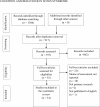Cognition and Behaviour in Sotos Syndrome: A Systematic Review
- PMID: 26872390
- PMCID: PMC4752321
- DOI: 10.1371/journal.pone.0149189
Cognition and Behaviour in Sotos Syndrome: A Systematic Review
Abstract
Background: Research investigating cognition and behaviour in Sotos syndrome has been sporadic and to date, there is no published overview of study findings.
Method: A systematic review of all published literature (1964-2015) presenting empirical data on cognition and behaviour in Sotos syndrome. Thirty four journal articles met inclusion criteria. Within this literature, data relating to cognition and/or behaviour in 247 individuals with a diagnosis of Sotos syndrome were reported. Ten papers reported group data on cognition and/or behaviour. The remaining papers employed a case study design.
Results: Intelligence quotient (IQ) scores were reported in twenty five studies. Intellectual disability (IQ < 70) or borderline intellectual functioning (IQ 70-84) was present in the vast majority of individuals with Sotos syndrome. Seven studies reported performance on subscales of intelligence tests. Data from these studies indicate that verbal IQ scores are consistently higher than performance IQ scores. Fourteen papers provided data on behavioural features of individuals with Sotos syndrome. Key themes that emerged in the behavioural literature were overlap with ASD, ADHD, anxiety and high prevalence of aggression/tantrums.
Conclusion: Although a range of studies have provided insight into cognition and behaviour in Sotos syndrome, specific profiles have not yet been fully specified. Recommendations for future research are provided.
Conflict of interest statement
Figures
References
-
- Tatton-Brown K, Rahman N (2004) Features of NSD1-positive Sotos syndrome. Clinical Dysmorphology 13: 199–204. - PubMed
-
- Sotos JF, Dodge PR, Muirhead D, Crawford JD, Talbot NB (1964) Cerebral gigantism in childhood. A syndrome of excessively rapid growth. The New England journal of medicine 271: 109–116. - PubMed
-
- Dodge PR, Holmes SJ, Sotos JF (1983) Cerebral gigantism. Developmental Medicine and Child Neurology 25: 248–252. - PubMed
-
- Melo DG, Acosta AX, Aparecida De Almeida Salles M, Monteiro De Pina-Neto J, Vieira De Castro JD, et al. (2002) Sotos syndrome (cerebral gigantism): Analysis of 8 cases. Arquivos de Neuro-Psiquiatria 60: 234–238. - PubMed
Publication types
MeSH terms
LinkOut - more resources
Full Text Sources
Other Literature Sources
Miscellaneous


